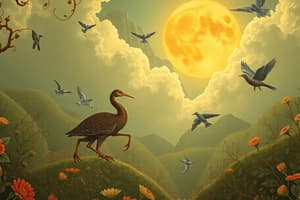Podcast
Questions and Answers
What is the primary mechanism driving the adaptation of populations to their environment?
What is the primary mechanism driving the adaptation of populations to their environment?
- Inheritance of acquired characteristics
- Natural selection (correct)
- Artificial selection
- Species mutation
What is the term for the process by which humans intentionally select and breed individuals with desired traits?
What is the term for the process by which humans intentionally select and breed individuals with desired traits?
- Genetic drift
- Natural selection
- Species adaptation
- Artificial selection (correct)
Which theory suggests that traits acquired through use or disuse during an individual's lifetime can be passed on to their offspring?
Which theory suggests that traits acquired through use or disuse during an individual's lifetime can be passed on to their offspring?
- Natural selection
- Artificial selection
- Inheritance of acquired characteristics (correct)
- Evolutionary development
What is the term for the process by which a species becomes better suited to its environment over time?
What is the term for the process by which a species becomes better suited to its environment over time?
Which of the following is an example of species adaptation?
Which of the following is an example of species adaptation?
What is a key component of natural selection?
What is a key component of natural selection?
What is the study of the evolution of developmental processes and patterns?
What is the study of the evolution of developmental processes and patterns?
What is an example of evolutionary development (Evo-Devo)?
What is an example of evolutionary development (Evo-Devo)?
Which of the following is NOT a process of evolution?
Which of the following is NOT a process of evolution?
What is the result of the accumulation of adaptations through natural selection?
What is the result of the accumulation of adaptations through natural selection?
Flashcards are hidden until you start studying
Study Notes
Evolutionary Theories
Natural Selection
- Also known as "survival of the fittest"
- Process by which individuals with favorable traits are more likely to survive and reproduce, passing those traits to their offspring
- Results in adaptation of populations to their environment
- Key components:
- Variation in population: differences in traits among individuals
- Heritability: traits are passed from parents to offspring
- Differential reproduction: individuals with favorable traits reproduce more successfully
Artificial Selection
- Process by which humans intentionally select and breed individuals with desired traits
- Used in agriculture, animal breeding, and biotechnology
- Results in rapid adaptation of populations to human needs
- Examples:
- Breeding of crops for desirable traits (e.g. disease resistance, increased yield)
- Selection of livestock for specific characteristics (e.g. milk production, meat quality)
Inheritance of Acquired Characteristics
- Discredited theory that traits acquired through use or disuse during an individual's lifetime can be passed on to their offspring
- Also known as Lamarckism
- Not supported by scientific evidence and contradicts modern understanding of genetics and evolution
Species Adaptation
- Process by which a species becomes better suited to its environment over time
- Results from the accumulation of adaptations through natural selection
- Examples:
- Peppered moths adapting to industrial pollution in England
- Antibiotic resistance in bacteria
Evolutionary Development (Evo-Devo)
- Study of the evolution of developmental processes and patterns
- Examines how developmental genes and pathways have evolved across species
- Reveals conserved developmental mechanisms across diverse species
- Examples:
- Similarities in embryonic development across vertebrates
- Evolution of wing development in insects and vertebrates
Evolutionary Theories
Natural Selection
- Also known as "survival of the fittest"
- Process by which individuals with favorable traits are more likely to survive and reproduce, passing those traits to their offspring
- Results in adaptation of populations to their environment
- Requires three key components: variation in population, heritability, and differential reproduction
- Variation in population refers to differences in traits among individuals
- Heritability means traits are passed from parents to offspring
- Differential reproduction means individuals with favorable traits reproduce more successfully
Artificial Selection
- Process by which humans intentionally select and breed individuals with desired traits
- Used in agriculture, animal breeding, and biotechnology
- Results in rapid adaptation of populations to human needs
- Examples include breeding crops for desirable traits like disease resistance or increased yield
- Examples also include selecting livestock for specific characteristics like milk production or meat quality
Inheritance of Acquired Characteristics
- Discredited theory that traits acquired through use or disuse during an individual's lifetime can be passed on to their offspring
- Also known as Lamarckism
- Not supported by scientific evidence and contradicts modern understanding of genetics and evolution
Species Adaptation
- Process by which a species becomes better suited to its environment over time
- Results from the accumulation of adaptations through natural selection
- Examples include peppered moths adapting to industrial pollution in England
- Examples also include antibiotic resistance in bacteria
Evolutionary Development (Evo-Devo)
- Study of the evolution of developmental processes and patterns
- Examines how developmental genes and pathways have evolved across species
- Reveals conserved developmental mechanisms across diverse species
- Examples include similarities in embryonic development across vertebrates
- Examples also include evolution of wing development in insects and vertebrates
Studying That Suits You
Use AI to generate personalized quizzes and flashcards to suit your learning preferences.



